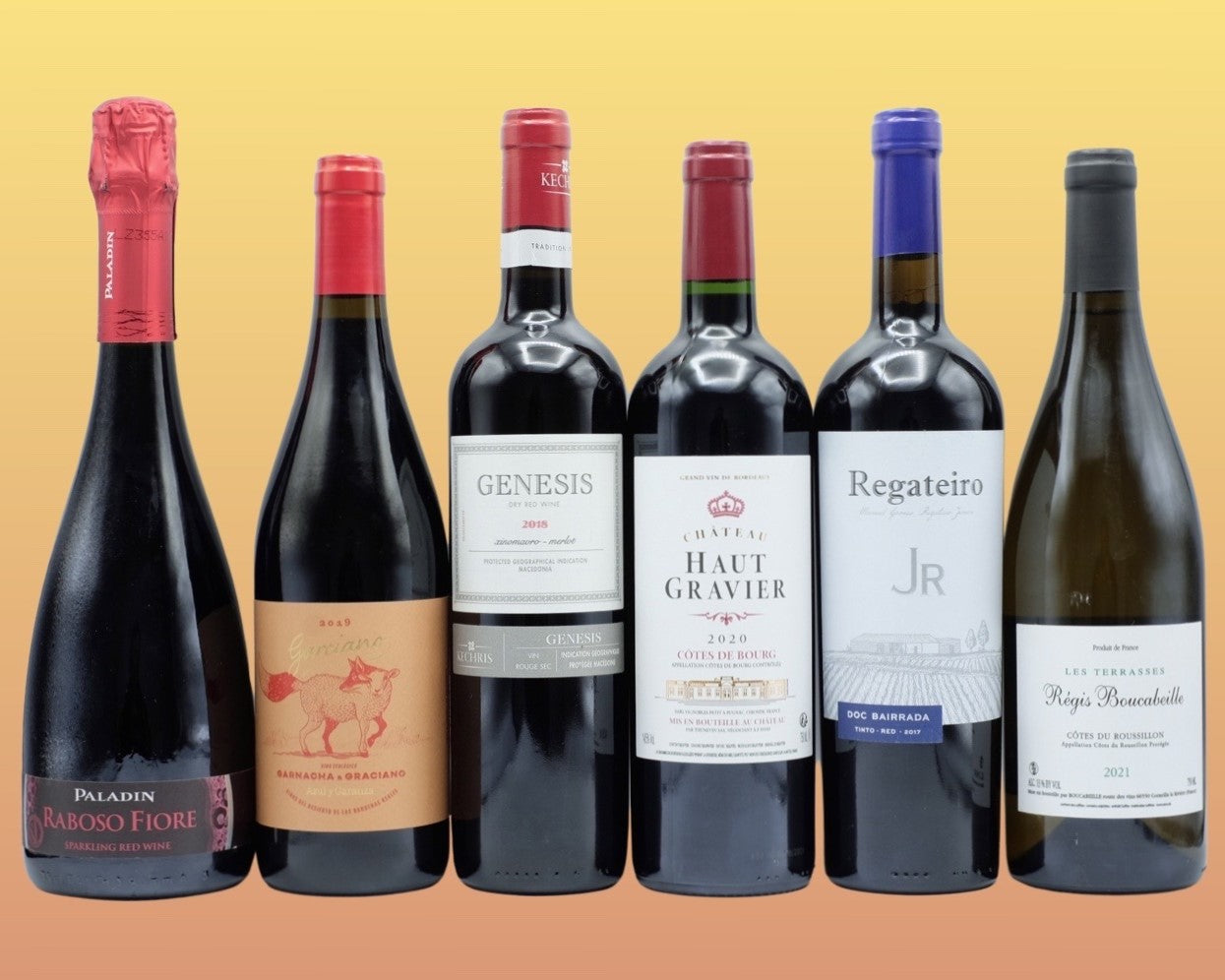| Hello and welcome to the newest edition of Vine Arts Wine Club! This month we’re introducing an all-European lineup of six new wines. Alongside classic varieties like Merlot and Garnacha, you’ll discover lesser known grapes such as Raboso, Graciano, Xinomavro and Baga. Bon appétit! For everyone signed up for pickup, your wines will be available Tuesday, November 1st. For everyone signed up for delivery, your wines will be delivered on Thursday, November 3rd. Cheers! |
| 2021 Paladin Raboso Fiore Veneto, Italy $24.45 | Where The Veneto is an incredibly important area for Italian wine production, home to some of Italy’s most highly regarded wine styles - Valpolicella, Amarone, Soave and Prosecco to name a few. Its borders were drawn around those of the once mighty Repubblica di Venezia, which controlled northeastern Italy for hundreds of years. From the foothills of the Alps to the broad plains of the Po Valley, the landscape changes markedly. Likewise, the climate varies based on elevation and the closeness to the Adriatic, Lake Garda, or the mountains. What Move over Lambrusco, there’s another red sparkling wine in town! This example is made from the indegenous northern Italian grape variety Raboso. As is often the case with Italian grape names, “Raboso'' actually refers to a family of closely related grapes. Technically speaking there’s Raboso Piave and Raboso Veronese. As the two varieties are commonly interplanted, Paladin doesn’t specify whether the wine is made from a blend of both, or just one of the two. Commonly mistaken for one another in the vineyard, both are known for deep color and high levels of anthocyanins. The Paladin Raboso Fiore was bottled with 20 g/l of residual sugar to soften Raboso’s aggressive tannins. The name Raboso is actually thought to have derived from the Italian word “rabbioso'', meaning angry. Who Casa Paladin was founded by Valentino Paladin back in 1962. Owned by the same family today, the business has grown to include additional projects within Veneto, and also in Lombardy and Tuscany: Bosco del Merlo, Castello Bonomi, and Fattoria di Castelvecchi. Helmed by Carlo and Roberto Paladin, the estate is farmed according to lutte raisonnée (‘reasoned viticulture’) principles, and the wines are made with 50% less sulfites than is typical. Also, all of the wines are vegan certified. Taste The Paladin Raboso Fiore is a juicy and intriguing twist on Italian bubbly. Ruby red in appearance with purple inflections, on the nose there are fragrant aromas of violet, succulent red cherry, and elderberry. Frothy effervescence on the palate is complemented by delicate astringency and a touch of sweetness. Pleasantly fruity with lush red fruit flavors, the refreshing finish invites you back for another mouthwatering sip. When enjoying this wine treat yourself to a food pairing with rich meaty flavors, like tagliatelle alla bolognese. |
| 2020 Château Haut Gravier Côtes de Bourg Bordeaux, France $19.51 | Where Bordeaux is huge. Located in the southwest of France, it covers an impressive 120,000 hectares. It’s by some margin the largest wine region in the country. The primary feature of the region is the Gironde estuary, a major artery for much of France’s ocean going trade. Locals say that the best estates can “see the river”. The city of Bordeaux itself has long been a major shipping hub going back to a time when Aquitaine was ruled by the English monarchy. Outsiders have played a major role in the region's good fortunes, including the English, Dutch, Americans, and most recently, the Chinese. The region can be further broken down into three areas: the Left Bank, the Entre-Deux-Mers (Between Two Seas), and the Right Bank. Interestingly the Medoc, home to the region's most prestigious wineries, was a dingy salt marsh until Dutch engineers drained it in the 1600’s. You can thank a guy called Jan for that. What The Bordeaux red blend of Cabernet Sauvignon, Merlot, Cabernet Franc, and Petit Verdot has been duplicated around the world. The USA has the dubious honor of creating the term “Meritage” to describe this combination of grapes. Generally speaking, wines from the Left Bank will be Cab Sauv dominant, while Right Bank wines will be Merlot dominant. Cab Sauv ripens more successfully when planted on well-drained gravel “croupes”, while Merlot ripens more fully on terroirs of limestone, clay, gravel, and clay. The 2020 Château Haut Gravier is made from a blend of 70% Merlot, 15% Cabernet Sauvignon, and 15% Malbec harvested from vineyards in Côtes de Bourg. Situated 35 km north of Bordeaux city, this area is known as “Little Switzerland” due to its rolling topography. For vinification, the winery used stainless steel tanks for fermentation and maturation. Who Château Haut Gravier is located in the Bordelais village of Pugnac. Operated by the same family for two generations, the winery has been managed by Christine Petit since 1995. The estate’s 11 hectares of vineyards have received HVE3 certification, which is a stamp of approval for sustainable and biodiverse farming practices. The principal grape variety is Merlot, which does well in Château Haut Gravier’s gravel-clay soils. Taste The Château Haut Gravier Côtes de Bourg is a friendly, plush and plummy Bordeaux Rouge. Dark garnet red in appearance, the nose has concentrated aromas of black plum, black currant, tobacco, and coffee grounds. The palate is medium-full bodied with round mouthfeel, supple tannins and tender flavors of black cherry and dark chocolate. The finish is robust and dry. For food pairings, we suggest serving this wine with grilled lamb shoulder or tea smoked duck breast with hoisin sauce |
| 2019 Azul y Garanza Garciano Navarra, Spain $27.18 | Where The Azul y Garanza wine estate lies on the edge of one of the driest, most arid sections of northern Spain - the badlands of Bardenas Reales. Located in southeastern Navarra, the landscape here is almost lunar in nature. Vegetation and rainfall are nearly nonexistent. Compared to the more northern areas of Navarra, the Bay of Biscay has little moderating influence. Only the hardiest of grape vines can thrive under these difficult conditions. What The blend for the Azul y Garanza Garciano is 60% Garnacha and 40% Graciano, two grape varieties well suited to growing conditions of Bardenas Reales. In fact, Garnacha has been pegged as the most important grape for all of Navarra. The best grapes are harvested from old dry-farmed bush vines that produce small amounts of exceptional fruit. In the north where temperatures are generally cooler, Garnacha based wines are typically fresher and more acidic. Garnacha from the south of Navarra tends to be plusher with firm tannins. Graciano in comparison is notably more aromatic and acidic. This makes Graciano a reliable blending partner for Garnacha. The fruit for the Garciano was harvested from two sites. The Garnacha was harvested from the organically farmed Las Placas vineyard. The Graciano was harvested from the Desierto vineyard, which is planted to extremely arid soils. Fermented in concrete tanks, the wine was aged 6 months in French oak barrels. Who Azul y Garanza was founded by Dani Sánchez, María Barrena and Fernando Barrena. The trio met while studying at viticultural school. Upon finishing their studies they decided to purchase an old winery in the town María and Fernando were raised in. The building was abandoned in the 1970’s and 80’s when grape growers were encouraged to rip out their vineyards. The winery needed a lot of work, but fortunately the original concrete tanks were salvageable. Venturing into the country they discovered some incredible patches of old vineyards. Some of the vines were over 100 years old! Today the wines of Azul y Garanza are made from organically farmed grapes harvested from two main areas - the pre-Pyrenees foothills near the village of Carcastillo, and in the gently rolling hills bordering the Bardenas Reales. All of the wines are made with minimal intervention. Taste This is one impishly wild little red wine! Light purple-crimson in appearance, on the nose juicy raspberry and red plum aromas are countered by aromas of black pepper and Mediterranean herbs. The palate is medium bodied with sheer tannins, sharp acidity and gutsy red-fruit flavors. On the finish the wine is earthy and spicy. Enjoy this wine with savory chorizo and potato stew. |
| 2018 Kechris Genesis Red Makedonia, Greece $27.18 | Where A major center for viticulture in northern Greece, Makedonia (aka Greek Macedonia) is strongly connected to the country's ancient past and its promising future. The grape vine has thrived here for thousands of years. Today the region is home to numerous important wine appellations - such as Amyndaio, Goumenissa and Naoussa. Much of the landscape is mountainous. Contrastingly, Makedonia is also home to the broad Thessaloniki-Giannitsa plain, the largest such flatland in Greece. Generally the best vineyards are planted to the region's more rocky mountain soils, which are less fertile and have good drainage. With both Mediterranean and continental influences, summers are generally hot and dry. During winter months vineyards are typically blanketed in snow. What The Kechris Genesis Red is made from a fifty-fifty split of Merlot and indegenous Xinomavro. Pronounced “ksino-mav-roh”, this tannic grape variety is behind Makedonia’s finest red wines. Dubbed the “Nebbiolo of Greece”, Xinomavro is grown mostly in mountainous areas like Naoussa. The grapes for the Genesis Red were harvested separately from vineyards located in the appellation of Goumenissa. Situated 50 km northwest of Thessaloniki, this lesser known area sits on the western slopes of Mount Paikos. Once the grapes reached the winery they were vinified separately, with 6 weeks of skin-maceration. Following fermentation the wine matured 8 months in oak barrels. Who Kechris is one of the most traditional family run wineries in Greece today. Located in Thessaloniki, the business was founded by Evagelos Kechris in 1911. During the 1930’s the family ran a popular taverna which served retsina and sun-dried grape wines from the barrel. This led to the establishment of a proper modern winery during the 1950’s. Eventually management of the business passed to Stelios Kechris, who still leads the winery today together with his daughters Eleni, Maria and Zoe. Trained at the University of Dijon, Stelios has merged tradition and modernity, crafting wines that are distinctly northern Greek in character. Taste The Kechris Genesis Red is a modern Greek wine that extends both the structure of Xinomavro and the plush fruit of Merlot. Bright ruby red in color, on the nose there are lush aromas of red plum, strawberry compote, sundried tomato, and French vanilla coffee. The palate is medium bodied with round tannins and savory red-fruit flavors. The finish is rich and mouth filling. We suggest serving this wine with the Greek taverna classic, pastitsio (a baked pasta dish made with ground beef and béchamel sauce). |
| 2017 Regateiro Jr Red Bairrada, Portugal $27.37 | Where Bairrada is a mid-sized Portuguese wine region positioned between the Atlantic Ocean and the Dão. The appellation’s 20,000 hectares of vineyards are spread across a largely flat and open landscape. Situated so close to the ocean (only 20km away), the climate of Bairrada is moderately maritime in character. Summers are hot and windy, while winters are mild and damp. During the growing season temperatures can swing wildly between day and night - sometimes by as much as 20°C. What Although winemaking in Bairrada goes as far back as the 10th century, its present-day manifestation harkens back to the year 1887. This was the year that the first viticulture school was established in Bairrada. Only 100 years prior many of the region's vineyards were uprooted to make way for Port production. It was just in 1980 that Bairrada was officially given a DOC (a protected designation of origin). In those 40 short years Bairrada has built a reputation around quality sparkling wines and red wines made from Baga. The Regateiro Jr Red is made from a blend of three grape varieties - Baga, Touriga Nacional, and Castelão. The dominant red grape of Bairrada, Baga is known for having thick skins and high natural acidity. Often compared to Pinot Noir and Nebbiolo, it can be fairly difficult to grow. For Regateiro Jr Red the grapes were partially macerated in a traditional treading lagar (tank). The rest was vinified in modern temperature controlled tanks. The wine was fully aged in stainless steel tanks. Who Manuel Gomes Regateiro Jr was an adventurer. Born in Aguada de Cima, he dreamed of seeing the world. Consumed by wanderlust he made his way to France, where he learned the intricacies of grape growing and winemaking. Returning to Bairrada years later, he established a successful tile manufacturing company. The proceeds allowed him to invest in his family's vineyards, setting the stage for future generations of winemakers. Not one to stay in one place too long, Manuel would eventually uproot himself again and sail to Brazil. His impact was such that when his grandson Casimiro Gomes decided to create a new wine brand, he named it after Manuel. Carrying his grandfather's torch, Casimiro collaborates with winemaker Sonia Martins to create wines with a strong Bairrada identity. Taste Dark ruby red in the glass, on the nose the Regateiro Jr Red exhibits earthy aromas of black currant, blackberry, tobacco, and forest floor. The medium-full bodied palate is robustly structured with chewy tannins. Piquant dried cherry and pomegranate flavors are lifted by smoky minerality and tidy acidity. The unoaked finish has a pleasing dash of anise and liquorice spice. We suggest serving this wine with roasted pork loin or smoked gouda cheese. |
| 2021 Domaine Boucabeille Les Terrasses de Régis Boucabeille Blanc Côtes du Roussillon, France $24.00 | Where Although often conjoined with neighboring Languedoc, the region of Roussillon has a distinct personality and history. Positioned next to the Mediterranean Sea in the shadow of the Pyrenees Mountains in southwestern France, the landscape is made up of fertile valleys ideal for agriculture. Vineyard plantings are concentrated in the regions east, as the west is too mountainous for viticulture. Historically the Roussillon was part of the Principality of Catalonia, and is still called Northern Catalonia by Catalan nationalists. Ceded to France in the 1600’s, today half of the people in Roussillon still understand the Catalan language. What With 316 days of sunshine, 22 inches of rainfall, and dry winds, Roussillon has the perfect climate for growing grapes. Thanks to the ideal conditions, the region has the highest percentage of organically and biodynamically farmed vineyards in all of France. Although it is well known for fortified sweet wines called Vin Doux Naturel, four out of every five Roussillon wines are dry. The Domaine Boucabeille Les Terrasses de Régis Boucabeille Blanc is made from a blend of 50% Grenache Blanc, 20% Grenache Gris, 20% Macabeu, and 10% Roussanne. The grapes were harvested from organically farmed terraced vineyards. Who Located just outside the village of Corneilla-de-la-Rivière, Domaine Boucabeille is run by winemaker Jean Boucabeille. The estate covers 28 hectares of vines planted mostly on the steep, schist, south-facing hillsides of the Força Real Mountain. Classic rocky Roussillon scrubland, the vineyards lie between 150 and 400 meters of elevation. Farmed for centuries, the area was largely abandoned during the 20th century due to the laborious conditions imposed by the rough terrain. In order to farm organically, Jean has replanted many of the vineyards. Much of the garrigue (low-lying vegetation) had to be ripped out by hand. Jean’s approach in the cellar is very non-intrusive. Spontaneous fermentations are done in concrete tanks, and oak aging is minimal. Taste Straw yellow in color, on the nose the Domaine Boucabeille Les Terrasses de Régis Boucabeille Blanc exhibits a bouquet of ripe golden delicious apple, fresh pineapple, and peach pudding. Creamy texture on the palate is complemented by ripe orchard fruit flavors and tart acidity. On the finish you find sharp minerality and a touch of reductive smokiness. A versatile food pairing wine, it’s a fine match for garden-fresh salads or traditional Roussillon bourride (a fish stew similar to bouillabaisse). |


